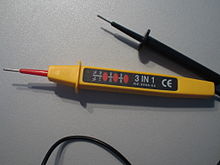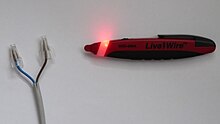Test light: Difference between revisions
m Dated {{Merge from}}. (Build p613) |
Wtshymanski (talk | contribs) a reference |
||
| Line 5: | Line 5: | ||
A '''test light''', '''test lamp''', '''voltage tester''', or '''mains tester''' is a very simple piece of [[electronic test equipment]] used to determine the presence or absence of an [[Electricity|electric]] [[voltage]] in a piece of equipment under test. |
A '''test light''', '''test lamp''', '''voltage tester''', or '''mains tester''' is a very simple piece of [[electronic test equipment]] used to determine the presence or absence of an [[Electricity|electric]] [[voltage]] in a piece of equipment under test. |
||
The test light is simply an electric lamp connected with one or two [[Electrical insulation|insulated]] [[wire]] leads. Often, it takes the form of a [[screwdriver]] with the lamp connected between the tip of the screwdriver and a single lead that projects out the back of the screwdriver. By connecting the flying lead to an earth (ground) reference and touching the screwdriver tip to various points in the circuit, the presence or absence of voltage at each point can be determined and simple faults detected and traced to their root cause. |
The test light is simply an electric lamp connected with one or two [[Electrical insulation|insulated]] [[wire]] leads. <ref name=Suummers87> Terrel Croft, Wilford Summers ''American Electricians' Handbook, Eleventh Edition'',k Mc Graw Hill, 1987 ISBN 0-07-013932-6 pages 1-56 through 1-57</ref>Often, it takes the form of a [[screwdriver]] with the lamp connected between the tip of the screwdriver and a single lead that projects out the back of the screwdriver. By connecting the flying lead to an earth (ground) reference and touching the screwdriver tip to various points in the circuit, the presence or absence of voltage at each point can be determined and simple faults detected and traced to their root cause. For higher voltages, a ''statiscope'' consists of a neon glow tube mounted on a long insulating handle; it can detect ac voltages of 2000 volts or more. |
||
For low voltage work (for example, in [[automobile]]s), the lamp used is usually a small, low-voltage [[incandescent light bulb]]. These lamps usually are designed to operate on approximately 12 V. |
For low voltage work (for example, in [[automobile]]s), the lamp used is usually a small, low-voltage [[incandescent light bulb]]. These lamps usually are designed to operate on approximately 12 V. |
||
| Line 12: | Line 12: | ||
[[File:Spanningszoeker.jpg|thumb|right| A voltage tester with three lamps to give an approximate indication of voltage magnitude]] |
[[File:Spanningszoeker.jpg|thumb|right| A voltage tester with three lamps to give an approximate indication of voltage magnitude]] |
||
Incandescent bulbs may also be used in some electronic equipment repair, and a trained technician can usually tell the approximate voltage by using the brightness as a crude indicator. |
|||
[[File:Kopp GVD-505A wireless tester.JPG|thumb|alt=The tip of this non-contact pen-shaped tester lights up near live wires|Non-contact voltage tester detects the electric field around live wires]] |
[[File:Kopp GVD-505A wireless tester.JPG|thumb|alt=The tip of this non-contact pen-shaped tester lights up near live wires|Non-contact voltage tester detects the electric field around live wires]] |
||
Revision as of 23:51, 16 August 2011
It has been suggested that Electrical tester pen be merged into this article. (Discuss) Proposed since August 2011. |


A test light, test lamp, voltage tester, or mains tester is a very simple piece of electronic test equipment used to determine the presence or absence of an electric voltage in a piece of equipment under test.
The test light is simply an electric lamp connected with one or two insulated wire leads. [1]Often, it takes the form of a screwdriver with the lamp connected between the tip of the screwdriver and a single lead that projects out the back of the screwdriver. By connecting the flying lead to an earth (ground) reference and touching the screwdriver tip to various points in the circuit, the presence or absence of voltage at each point can be determined and simple faults detected and traced to their root cause. For higher voltages, a statiscope consists of a neon glow tube mounted on a long insulating handle; it can detect ac voltages of 2000 volts or more.
For low voltage work (for example, in automobiles), the lamp used is usually a small, low-voltage incandescent light bulb. These lamps usually are designed to operate on approximately 12 V.
For line voltage (mains) work, the lamp is usually a small neon lamp connected in series with an appropriate ballast resistor. These lamps often can operate across a wide range of voltages from 90V up to several hundred volts. In some cases, several separate lamps are used with resistive voltage dividers arranged to allow additional lamps to strike as the applied voltage rises higher; with the lamps mounted in order from lowest voltage to highest, this minimal bar graph provides a crude indication of voltage.

Incandescent bulbs may also be used in some electronic equipment repair, and a trained technician can usually tell the approximate voltage by using the brightness as a crude indicator.

See also
References
- ^ Terrel Croft, Wilford Summers American Electricians' Handbook, Eleventh Edition,k Mc Graw Hill, 1987 ISBN 0-07-013932-6 pages 1-56 through 1-57
